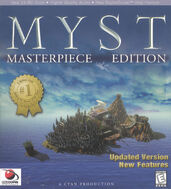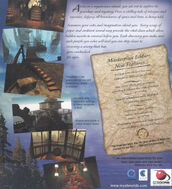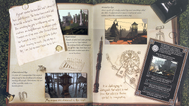| Attention Needed - Article Stub This particular article is still lacking the necessary information, images, and/or general formatting. You can assist D'ni by improving it. |
"Myst" is the first game in the series, originally released on September 24th, 1993 by Cyan Worlds.
Myst was created by Cyan Worlds to be an immersive experience, rather than a typical game. Several of the game's main features were introduced as a means to immerse people more fully, such as the game being in 3D, the inability to die or lose and modeling additional details that no one would really notice (such as individual screws).
Plot[]
The game begins with Atrus falling down into the Star Fissure and dropping a Myst Linking Book. The Stranger, the name given to the player by Myst fans, finds the book and subsequently links to Myst, where they are tasked with exploring the island.
Their first encounter with another human on the island is with Sirrus and Achenar, who are trapped within the red and blue books and request that The Stranger visit the ages to find the pages to their books to free them.
As The Stranger explores the four ages, Sirrus and Achenar begin to tell him/her more about their imprisonment and past, explaining that they are the sons of Atrus and Catherine and that their father Atrus wrote the ages. However, each blames the other for the destruction of the books in The Library with Achenar blaming Sirrus' greed and Sirrus blaming Achenar's instability. Though their stories conflict, each figure that Atrus is dead and they are forever trapped in their prisons.
After returning all four pages from the ages, they both tell The Stranger to find a pattern in a burnt book and use it in the fireplace, which will lead them to their final pages. They both warn The Stranger not to touch the green book, as they will become trapped there forever.
At this point, players can experience either the two bad endings or the good ending. The first bad ending results from bringing the red page back to Sirrus, who swaps places with The Stranger. Sirrus laughs at him/her and tears the pages from the book, eager to find Achenar. The second ending is similar and results from bringing the blue page back to Achenar. He gloats as The Stranger becomes trapped in the Blue Book and tears out the blue pages, stranding them there.
The good ending is achieved by finding a white page and bringing it to the green book, which contains Atrus. However, Atrus is stuck within the book (as Sirrus and Achenar had torn a single white page from his linking book, stranding him there) and requests The Stranger find the missing page. If the player links to the D'ni age before finding the page, they become stuck there with Atrus forever. If they bring the page, Atrus links back to Myst and appears to burn the Red and Blue books containing Sirrus and Achenar (though later games contradict this). He then asks The Stranger for their help in fighting Gehn and rescuing Catherine on Riven, setting up the events of the next game.
Ages[]
Ages Visited[] |
Ages Mentioned[] |
Gameplay[]
- "3-D"
The original gameplay of Myst was different than nearly any game that had been made before it. Rand and Robyn Miller had wanted the game to be made in a true 3-D environment, free for the player to explore, but due to technical limitations of the time, this was simply impossible (they later created a version of Myst like this, called realMyst). The game was instead created as a series of pre-rendered 3-D images, arranged into a hypercard stack. The player then navigates through the stack, seemingly traveling around the island. In addition, there were some animations and videos created for the game. All in all, more than 2500 images were created and over 60 minutes of video were shot for the finished game.
- Dithering
Another technical limitation faced by the original Myst game was the graphical capabilities of computers at the time. While the images created were rendered in millions of colors, most computers at the time could only handle 256 colors. This was solved by dithering all the images in the game. In order for the dithering to work, a special palette of 256 colors were created for each age. The palette changes were disguised within the black screens during the transition between ages.
- 1st-Person
Myst is also significant because it is one of the first games to use 1st person perspective and is regarded as one of the games that uses it most effectively. The 1st person perspective essentially puts the user into the game and makes them feel like they really are experiencing the events in the game.
- Navigation
The majority of the game is navigated by clicking on the side of the screen that corresponds to the direction that the user wants to move. Users can also click on books to open them, click on pages to turn them, and click on panels to link to the ages. Puzzles require you to click on various components to solve them as well. You may also need to click on drawers to open them. Players can grab and hold pages, but nothing else.
Development[]
| Attention Needed - Article Stub This particular article is still lacking the necessary information, images, and/or general formatting. You can assist D'ni by improving it. |
In early concepts of the game, travel between worlds would be made through paintings and exotic machinery. In some scenario, there were two brothers, sons of a "greater being", who created worlds together, until one of the brothers turned evil. As their father didn't know which one destroyed the worlds, he decided to lock up both of them. Something happened to their father on his way back to Myst from a long journey, and only the Myst book was found on him by the player. The main objective of the game was to travel between worlds, discover clues about the brothers's identities, and eventually reach a room containing the Red and Blue Pages, and the "warp gate" back to Myst. Some of the lost mentioned ages would be Mammoth Age, Ivory Age and Night Age.[1][2]
The developers mainly used Strata Studio Pro on Macintoshes. During development, the team members worked individually from their homes, and as there was no Internet, they drove to each other's house with a disk in order to show their progress (Chris Brandcamp called this system "car-net").[3]
Over a 100 of sound effects were created by Brandcamp who, having no previous experience on sound engineering, resolved to improvisional ways, like knocking recycle bins, blowing straws and air guns, ringing metal pipes and wrenches, and famously blowing bubbles in a toilet seat.[4]Cite error: Closing </ref> missing for <ref> tag
Release[]
It was extraordinarily successful and became the #1 selling PC game of all time, selling 6,000,000 copies, where it remained #1 until 2001, when it was overtaken by The Sims. The game was very well received, with reviewers noting the unique gameplay, challenging puzzles and inability to lose as high points of the game. Due to the large amount of images and data, this game was one of the first games ever released on CD. Many experts cite Myst as the leading cause of CD Rom sales and the popularity of the device in modern culture.
It won the Software Publishers Association's Best User Interface, Best Fantasy/Role Playing Game, Critic's Choice for Best Consumer Program and many other awards. Notably it has been praised in non-technical press, such as Rolling Stone and Newsweek.
Remakes[]
Masterpiece Edition[]
Myst: Masterpiece Edition was an updated version of the original Myst game. Since Myst was a huge success in the 1990s, it was re-released with many improvements. The images were enhanced with 24-bit true-color, and the sound was also enhanced. The transitions were noticeably smoother when compared to original Myst.
realMyst[]
- See Also: realMyst
To be Added
Gallery[]
Notes & Trivia[]
- This game was the best selling PC game of all time until 2001, when it was overtaken by The Sims. It is currently the 8th best selling PC game of all time.
- Myst was featured in the April 27, 2014 comic of Bill Holbrooks' On the Fastrack, noting its 20th anniversary.
See Also[]
| Myst Series | |||
|---|---|---|---|
| Main Series | Myst • Riven: The Sequel to Myst • Myst III: Exile • Myst IV: Revelation • Myst V: End of Ages | ||
| Uru Series | Uru: Ages Beyond Myst • To D'ni • The Path of the Shell • Myst Online: Uru Live | ||
| Other | Myst: Masterpiece Edition • RealMyst • RealMyst: Masterpiece Edition • Uru: Complete Chronicles | ||
| Novels | The Book of Atrus • The Book of Ti'ana • The Book of D'ni • The Book of Marrim | ||





